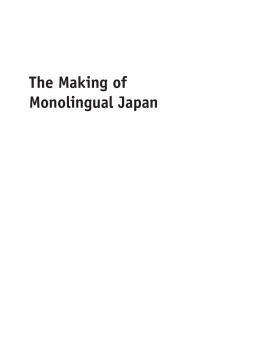
Additional Information
Book Details
Abstract
Japan is widely regarded as a model case of successful language modernization, and it is often erroneously believed to be linguistically homogenous. There is a connection between these two views. As the first ever non-Western language to be modernized, Japanese language modernizers needed to convince the West that Japanese was just as good a language as the national languages of the West. The result was a fervent desire for linguistic uniformity. Today the legacy of modernist language ideology poses many problems to an internationalizing Japan. All indigenous minority languages are heading towards extinction, and this purposefully created homogeneity also affects the integration of immigrants and their languages. This book examines these issues from the perspective of language ideology, and in doing so the mechanisms by which language ideology undermines linguistic diversity are revealed.
Dr Heinrich's book gives the Anglophone world information that was not easily available before. Now there are no excuses for sweeping claims about Japan and its language practices. With this book we have the detail to permit more nuanced assessment.
The study of ideologies of language diversity is key to any understanding of modern language ecologies. Patrick Heinrich's monograph investigates the modernization of Japanese, tracks the rise of Japanese linguism and reveals the myth of Japan as a monolingual nation. He takes an active stance towards the subjugation of the Ryukyuan languages as mere dialects of Japanese as well as the repression of the language of the autochthonous Ainu. This publication presents a thorough analysis of the current language situation of Japan and provides an important reading on the impact of language ideologies on language ecologies.
This book stands as a tribute to Heinrich’s lengthy research on this topic drawing on a large number and broad range of native sources. Heinrich’s first-hand observations on the current state of language policy in Japan, its effects on language revitalization movements and suggestions in regards to future discussion of and research related to language policy are invaluable resources for researchers who lack the time or resources to pursue this type of in-depth study on their own. He has obviously considered multiple viewpoints and come to logical and well-constructed conclusions in developing his own approach to this complex issue. Heinrich’s work smoothly carries the reader along a winding chronological storyline. Topics likely unfamiliar to non-linguists and those less well-versed in ideological study are skillfully presented with little ambiguity.
In conclusion, this book is more than a welcome addition to recent monographs in English on language policy and language ideologies in Japan. Overall, Heinrich’s study convincingly narrates the formation of modern Japanese language ideology, drawing on a wide range of literature in Japanese, English and German. His sources include those that pay primary attention to historical developments within Japan and others anchored in language policy and ideology more broadly that serve to raise general theoretical concerns.
Patrick Heinrich is an associate professor at Dokkyo University, Japan. His research interests focus on language ideology, language endangerment, history of linguistics, and social aspects of foreign language learning. Recent publications include Higashi ajia ni okeru gengo fukko [Language Revitalization in East Asia] (co-edited with Shin Matsuo, Sangensha 2010), Language Life in Japan (co-edited with Christian Galan, Routledge, 2011), and Mezase! Ryukyu shogo no iji [In Pursuit of Ryukyuan Language Maintenance] (co-edited with Michinori Shimoji, CoCo Shuppan 2011). He is currently co-editing the Handbook of Ryukyuan Languages.
Table of Contents
| Section Title | Page | Action | Price |
|---|---|---|---|
| Contents | v | ||
| Preface | vii | ||
| 1 Language Ideology as a Field of Enquiry | 1 | ||
| 2 The Call of Mori Arinori to Replace Japanese | 21 | ||
| 3 The Creation of a Modern Voice | 42 | ||
| 4 The Unification of Japanese | 59 | ||
| 5 The Linguistic Assimilation of Ryukyuans and Ainu | 83 | ||
| 6 The Most Beautiful Language in the World | 107 | ||
| 7 Language Ideology as Self-Fulfilling Prophecy | 122 | ||
| 8 Current Challenges to Modernist Language Ideology | 150 | ||
| 9 Language Ideology in 21st-century Japan | 172 | ||
| References | 183 | ||
| Index | 202 |
